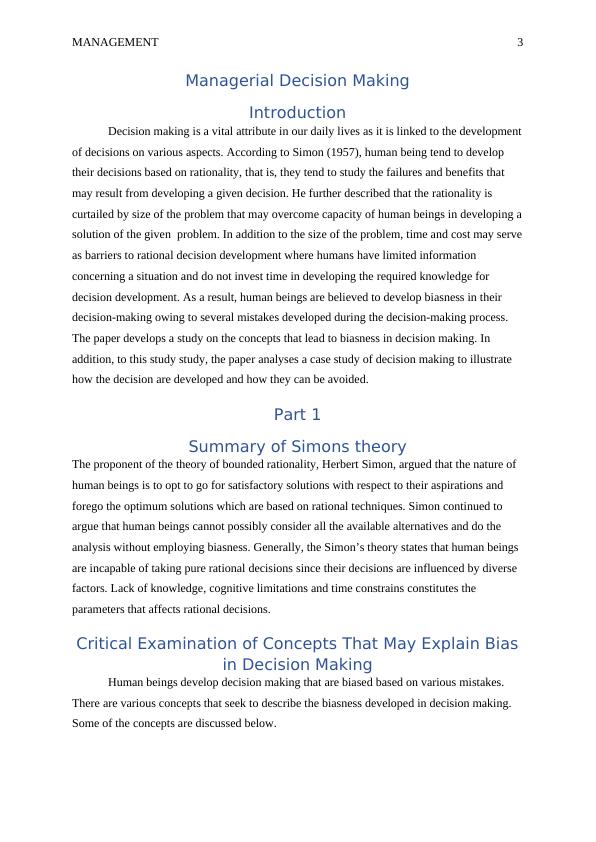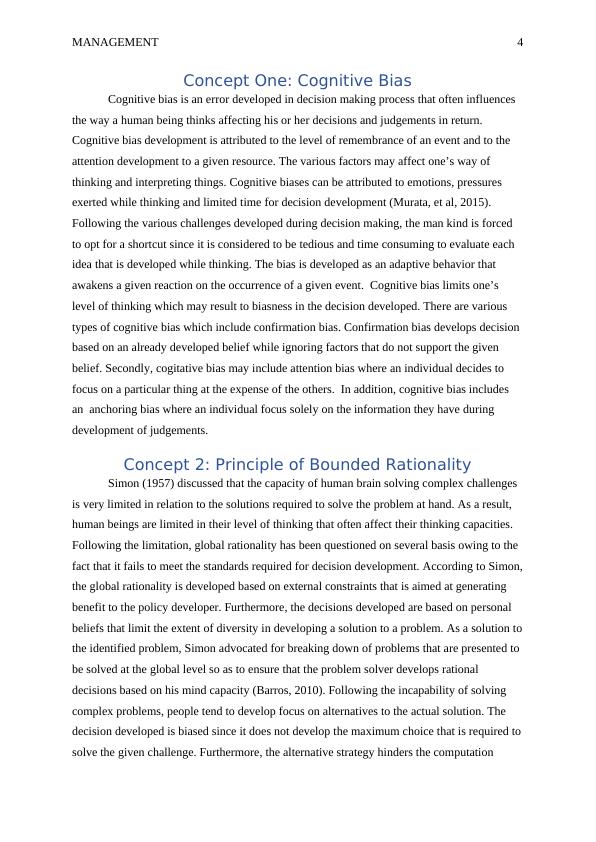Managerial Decision Making
12 Pages3720 Words466 Views
Added on 2023-04-21
About This Document
This article discusses the concepts that lead to biasness in decision making and provides strategies to overcome them. It also analyzes a case study to illustrate the development of biased decisions and how they can be avoided. Decision making is crucial for business growth, and avoiding bias can lead to better outcomes.
Managerial Decision Making
Added on 2023-04-21
ShareRelated Documents
Running head: MANAGEMENT 1
Managerial Decision Making
Name
Institution
Author note.........
Managerial Decision Making
Name
Institution
Author note.........

MANAGEMENT 2
Table of Contents
Managerial Decision Making.................................................................................................................3
Introduction...........................................................................................................................................3
Part 1.....................................................................................................................................................3
Summary of Simons theory...................................................................................................................3
Critical Examination of Concepts That May Explain Bias in Decision Making........................................3
Concept One: Cognitive Bias..................................................................................................................4
Concept 2: Principle of Bounded Rationality.........................................................................................4
Concept 3: Judgement Heuristics..........................................................................................................5
Concept 4: Availability Heuristics..........................................................................................................5
Summary...............................................................................................................................................6
Conclusion.............................................................................................................................................6
References.............................................................................................................................................7
Part 2.....................................................................................................................................................8
Introduction...........................................................................................................................................8
Cognitive Decision Making....................................................................................................................8
Decision Making Scenario..................................................................................................................8
Bias Identified from The Case............................................................................................................9
Strategies to Overcome the Bias Scenario.........................................................................................9
How the Move Will Improve Decision Outcomes?............................................................................9
2. Principle of Bounded Rationality.......................................................................................................9
Case Description................................................................................................................................9
Bias Identified from The Case..........................................................................................................10
Strategies to Overcome the Bias Scenario.......................................................................................10
How the Move Will Improve Decision Outcomes?..........................................................................10
Heuristics.............................................................................................................................................10
Case description..............................................................................................................................10
Bias Identified from The Case..........................................................................................................11
Strategies to Overcome the Bias Scenario.......................................................................................11
How the Move Will Improve Decision Outcomes?..........................................................................11
Conclusion...........................................................................................................................................11
References...........................................................................................................................................12
Table of Contents
Managerial Decision Making.................................................................................................................3
Introduction...........................................................................................................................................3
Part 1.....................................................................................................................................................3
Summary of Simons theory...................................................................................................................3
Critical Examination of Concepts That May Explain Bias in Decision Making........................................3
Concept One: Cognitive Bias..................................................................................................................4
Concept 2: Principle of Bounded Rationality.........................................................................................4
Concept 3: Judgement Heuristics..........................................................................................................5
Concept 4: Availability Heuristics..........................................................................................................5
Summary...............................................................................................................................................6
Conclusion.............................................................................................................................................6
References.............................................................................................................................................7
Part 2.....................................................................................................................................................8
Introduction...........................................................................................................................................8
Cognitive Decision Making....................................................................................................................8
Decision Making Scenario..................................................................................................................8
Bias Identified from The Case............................................................................................................9
Strategies to Overcome the Bias Scenario.........................................................................................9
How the Move Will Improve Decision Outcomes?............................................................................9
2. Principle of Bounded Rationality.......................................................................................................9
Case Description................................................................................................................................9
Bias Identified from The Case..........................................................................................................10
Strategies to Overcome the Bias Scenario.......................................................................................10
How the Move Will Improve Decision Outcomes?..........................................................................10
Heuristics.............................................................................................................................................10
Case description..............................................................................................................................10
Bias Identified from The Case..........................................................................................................11
Strategies to Overcome the Bias Scenario.......................................................................................11
How the Move Will Improve Decision Outcomes?..........................................................................11
Conclusion...........................................................................................................................................11
References...........................................................................................................................................12

MANAGEMENT 3
Managerial Decision Making
Introduction
Decision making is a vital attribute in our daily lives as it is linked to the development
of decisions on various aspects. According to Simon (1957), human being tend to develop
their decisions based on rationality, that is, they tend to study the failures and benefits that
may result from developing a given decision. He further described that the rationality is
curtailed by size of the problem that may overcome capacity of human beings in developing a
solution of the given problem. In addition to the size of the problem, time and cost may serve
as barriers to rational decision development where humans have limited information
concerning a situation and do not invest time in developing the required knowledge for
decision development. As a result, human beings are believed to develop biasness in their
decision-making owing to several mistakes developed during the decision-making process.
The paper develops a study on the concepts that lead to biasness in decision making. In
addition, to this study study, the paper analyses a case study of decision making to illustrate
how the decision are developed and how they can be avoided.
Part 1
Summary of Simons theory
The proponent of the theory of bounded rationality, Herbert Simon, argued that the nature of
human beings is to opt to go for satisfactory solutions with respect to their aspirations and
forego the optimum solutions which are based on rational techniques. Simon continued to
argue that human beings cannot possibly consider all the available alternatives and do the
analysis without employing biasness. Generally, the Simon’s theory states that human beings
are incapable of taking pure rational decisions since their decisions are influenced by diverse
factors. Lack of knowledge, cognitive limitations and time constrains constitutes the
parameters that affects rational decisions.
Critical Examination of Concepts That May Explain Bias
in Decision Making
Human beings develop decision making that are biased based on various mistakes.
There are various concepts that seek to describe the biasness developed in decision making.
Some of the concepts are discussed below.
Managerial Decision Making
Introduction
Decision making is a vital attribute in our daily lives as it is linked to the development
of decisions on various aspects. According to Simon (1957), human being tend to develop
their decisions based on rationality, that is, they tend to study the failures and benefits that
may result from developing a given decision. He further described that the rationality is
curtailed by size of the problem that may overcome capacity of human beings in developing a
solution of the given problem. In addition to the size of the problem, time and cost may serve
as barriers to rational decision development where humans have limited information
concerning a situation and do not invest time in developing the required knowledge for
decision development. As a result, human beings are believed to develop biasness in their
decision-making owing to several mistakes developed during the decision-making process.
The paper develops a study on the concepts that lead to biasness in decision making. In
addition, to this study study, the paper analyses a case study of decision making to illustrate
how the decision are developed and how they can be avoided.
Part 1
Summary of Simons theory
The proponent of the theory of bounded rationality, Herbert Simon, argued that the nature of
human beings is to opt to go for satisfactory solutions with respect to their aspirations and
forego the optimum solutions which are based on rational techniques. Simon continued to
argue that human beings cannot possibly consider all the available alternatives and do the
analysis without employing biasness. Generally, the Simon’s theory states that human beings
are incapable of taking pure rational decisions since their decisions are influenced by diverse
factors. Lack of knowledge, cognitive limitations and time constrains constitutes the
parameters that affects rational decisions.
Critical Examination of Concepts That May Explain Bias
in Decision Making
Human beings develop decision making that are biased based on various mistakes.
There are various concepts that seek to describe the biasness developed in decision making.
Some of the concepts are discussed below.

MANAGEMENT 4
Concept One: Cognitive Bias
Cognitive bias is an error developed in decision making process that often influences
the way a human being thinks affecting his or her decisions and judgements in return.
Cognitive bias development is attributed to the level of remembrance of an event and to the
attention development to a given resource. The various factors may affect one’s way of
thinking and interpreting things. Cognitive biases can be attributed to emotions, pressures
exerted while thinking and limited time for decision development (Murata, et al, 2015).
Following the various challenges developed during decision making, the man kind is forced
to opt for a shortcut since it is considered to be tedious and time consuming to evaluate each
idea that is developed while thinking. The bias is developed as an adaptive behavior that
awakens a given reaction on the occurrence of a given event. Cognitive bias limits one’s
level of thinking which may result to biasness in the decision developed. There are various
types of cognitive bias which include confirmation bias. Confirmation bias develops decision
based on an already developed belief while ignoring factors that do not support the given
belief. Secondly, cogitative bias may include attention bias where an individual decides to
focus on a particular thing at the expense of the others. In addition, cognitive bias includes
an anchoring bias where an individual focus solely on the information they have during
development of judgements.
Concept 2: Principle of Bounded Rationality
Simon (1957) discussed that the capacity of human brain solving complex challenges
is very limited in relation to the solutions required to solve the problem at hand. As a result,
human beings are limited in their level of thinking that often affect their thinking capacities.
Following the limitation, global rationality has been questioned on several basis owing to the
fact that it fails to meet the standards required for decision development. According to Simon,
the global rationality is developed based on external constraints that is aimed at generating
benefit to the policy developer. Furthermore, the decisions developed are based on personal
beliefs that limit the extent of diversity in developing a solution to a problem. As a solution to
the identified problem, Simon advocated for breaking down of problems that are presented to
be solved at the global level so as to ensure that the problem solver develops rational
decisions based on his mind capacity (Barros, 2010). Following the incapability of solving
complex problems, people tend to develop focus on alternatives to the actual solution. The
decision developed is biased since it does not develop the maximum choice that is required to
solve the given challenge. Furthermore, the alternative strategy hinders the computation
Concept One: Cognitive Bias
Cognitive bias is an error developed in decision making process that often influences
the way a human being thinks affecting his or her decisions and judgements in return.
Cognitive bias development is attributed to the level of remembrance of an event and to the
attention development to a given resource. The various factors may affect one’s way of
thinking and interpreting things. Cognitive biases can be attributed to emotions, pressures
exerted while thinking and limited time for decision development (Murata, et al, 2015).
Following the various challenges developed during decision making, the man kind is forced
to opt for a shortcut since it is considered to be tedious and time consuming to evaluate each
idea that is developed while thinking. The bias is developed as an adaptive behavior that
awakens a given reaction on the occurrence of a given event. Cognitive bias limits one’s
level of thinking which may result to biasness in the decision developed. There are various
types of cognitive bias which include confirmation bias. Confirmation bias develops decision
based on an already developed belief while ignoring factors that do not support the given
belief. Secondly, cogitative bias may include attention bias where an individual decides to
focus on a particular thing at the expense of the others. In addition, cognitive bias includes
an anchoring bias where an individual focus solely on the information they have during
development of judgements.
Concept 2: Principle of Bounded Rationality
Simon (1957) discussed that the capacity of human brain solving complex challenges
is very limited in relation to the solutions required to solve the problem at hand. As a result,
human beings are limited in their level of thinking that often affect their thinking capacities.
Following the limitation, global rationality has been questioned on several basis owing to the
fact that it fails to meet the standards required for decision development. According to Simon,
the global rationality is developed based on external constraints that is aimed at generating
benefit to the policy developer. Furthermore, the decisions developed are based on personal
beliefs that limit the extent of diversity in developing a solution to a problem. As a solution to
the identified problem, Simon advocated for breaking down of problems that are presented to
be solved at the global level so as to ensure that the problem solver develops rational
decisions based on his mind capacity (Barros, 2010). Following the incapability of solving
complex problems, people tend to develop focus on alternatives to the actual solution. The
decision developed is biased since it does not develop the maximum choice that is required to
solve the given challenge. Furthermore, the alternative strategy hinders the computation

End of preview
Want to access all the pages? Upload your documents or become a member.
Related Documents
Biases of Decision Making Processlg...
|12
|2861
|272
Assignment Concepts of Decision Makinglg...
|8
|2037
|49
The Process of Decision Makinglg...
|16
|4316
|237
Explaining Biases in Decision Making (Doc)lg...
|16
|4788
|76
9 Examples of Managerial Decisionslg...
|9
|2260
|13
Psychological Aspect And Decision Makinglg...
|10
|2107
|14
